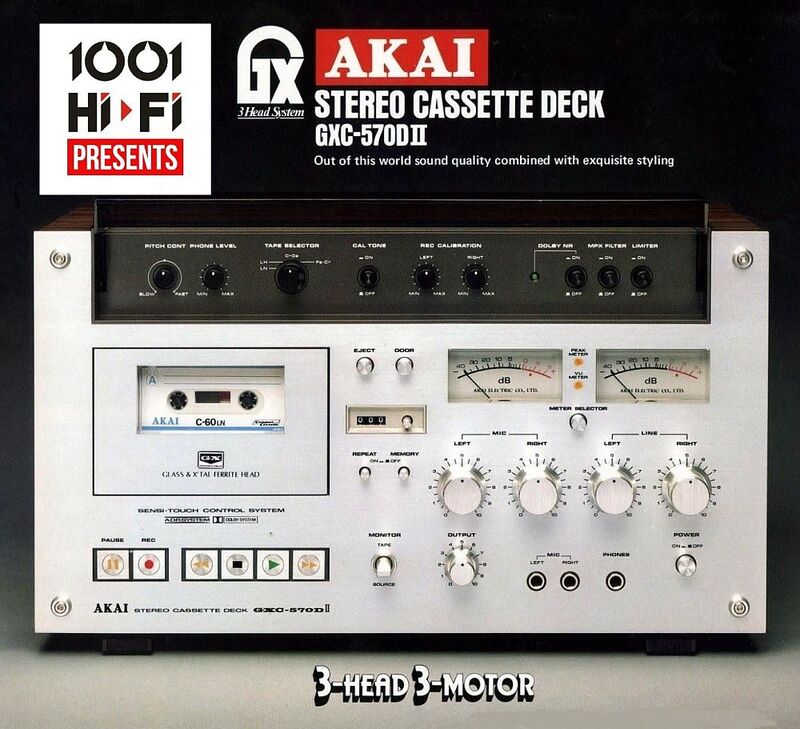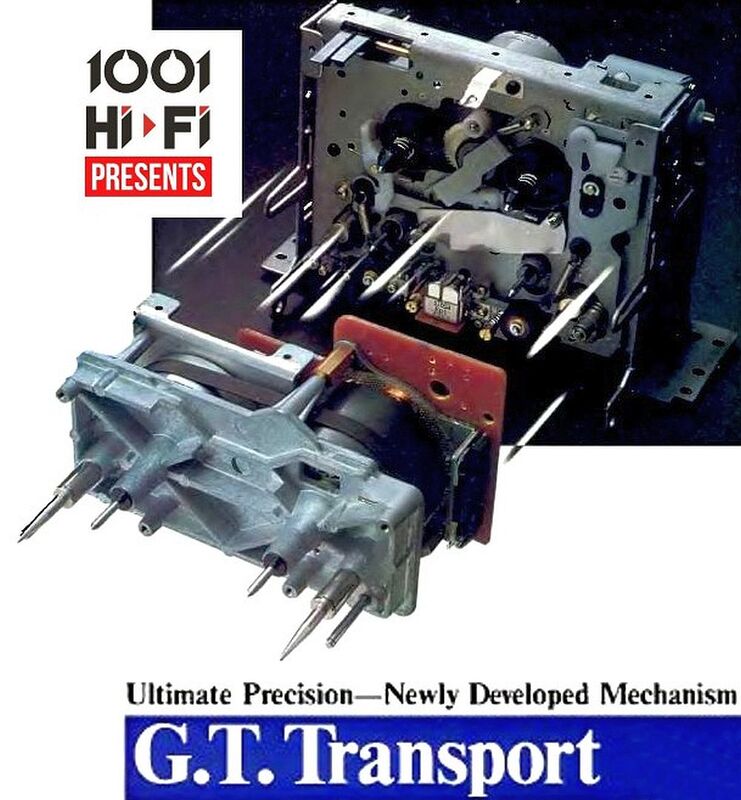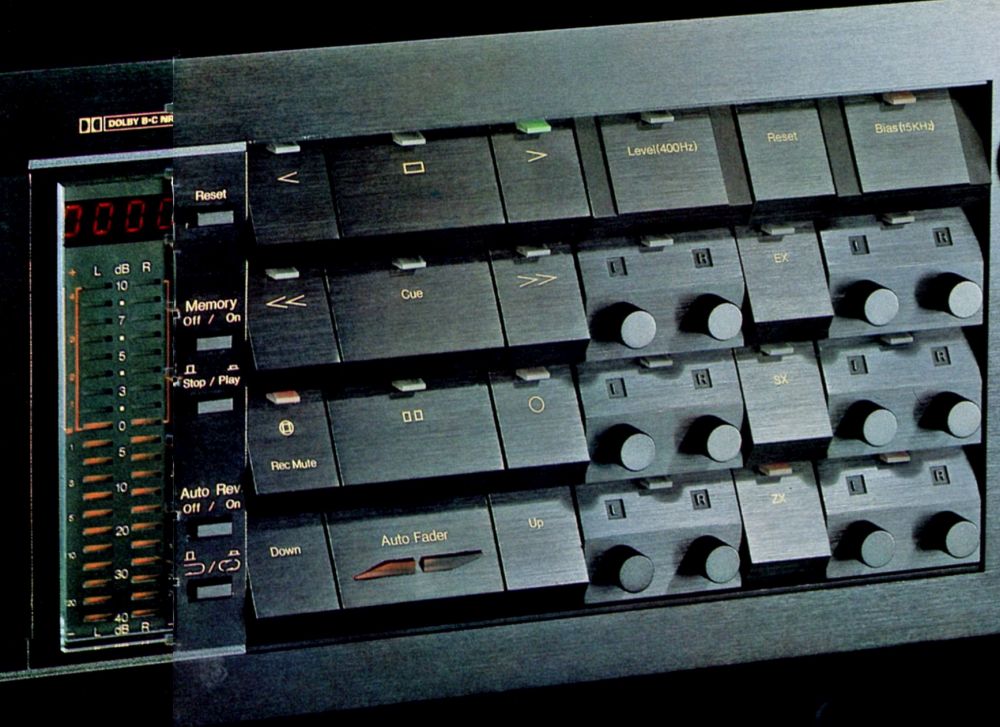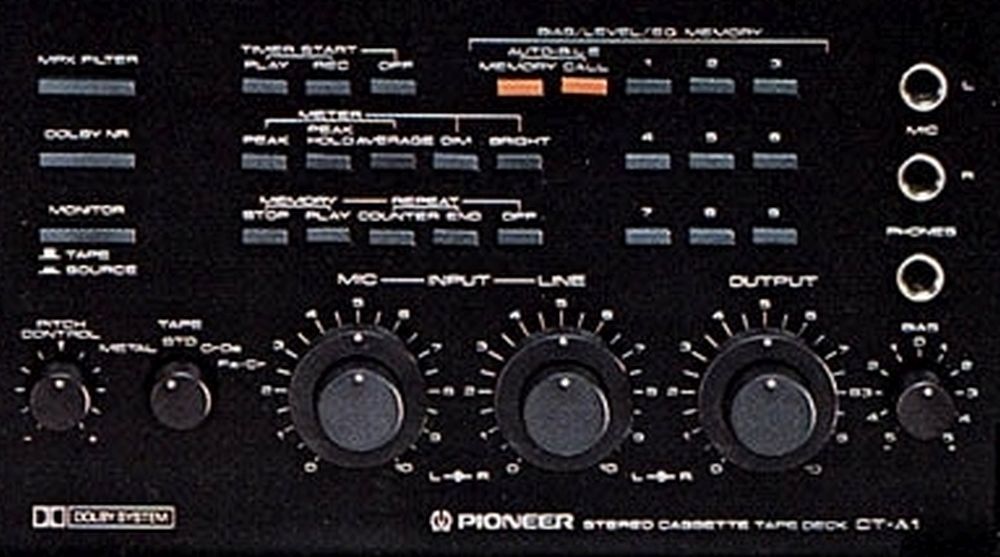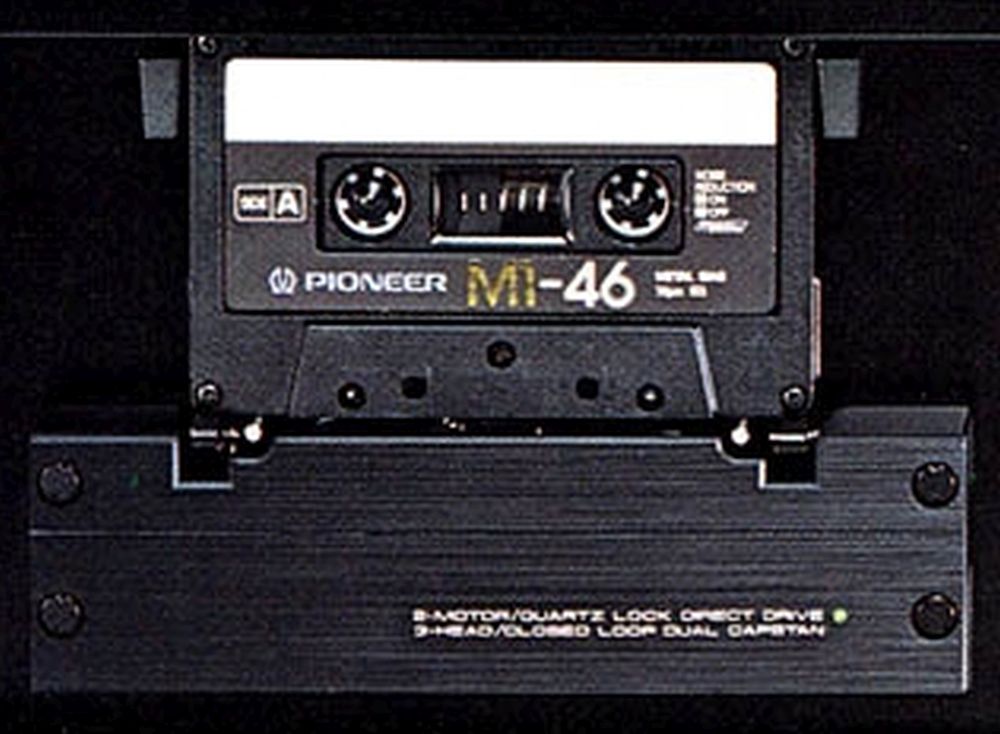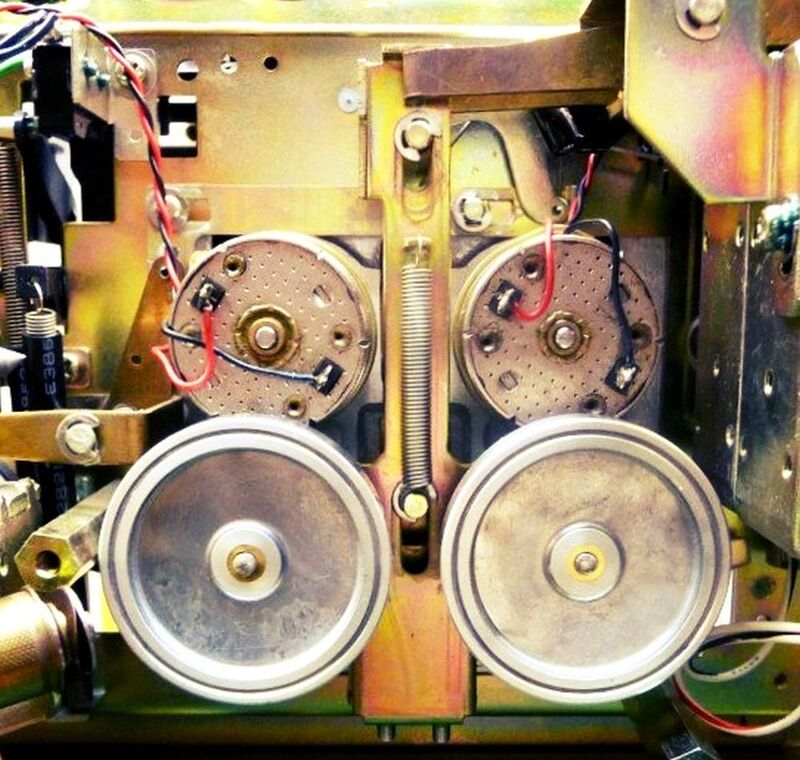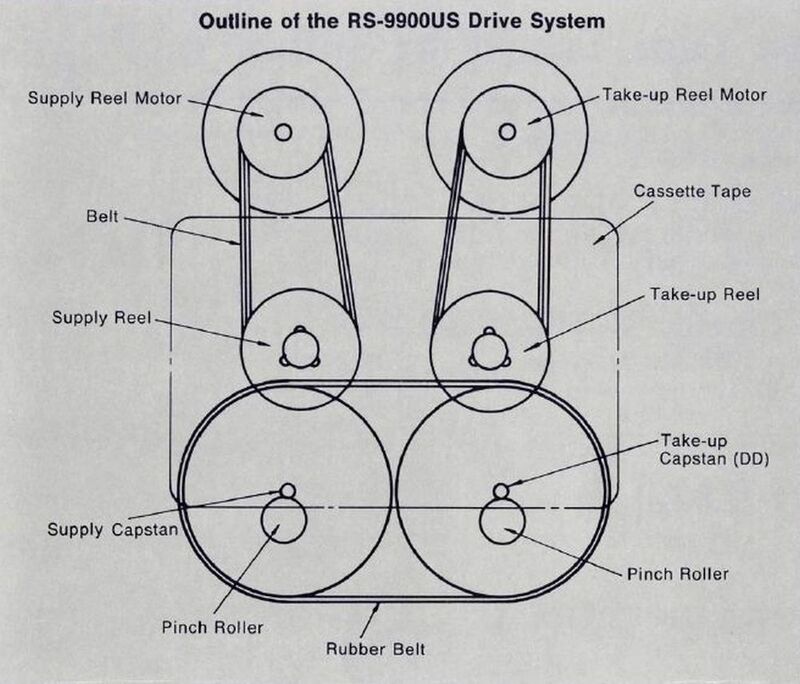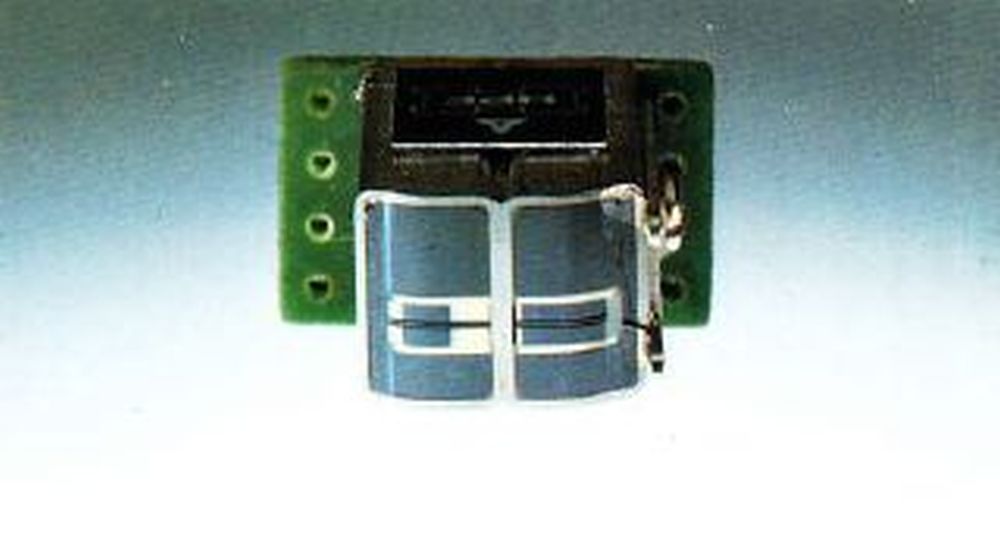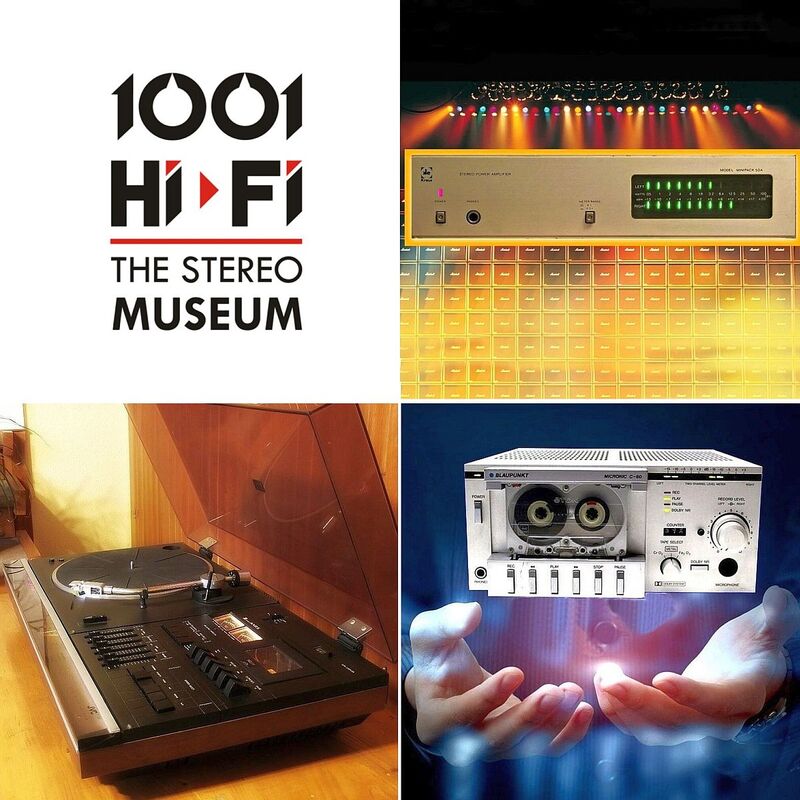AKAI GXC-570D (JAPAN 1978)
This prestige tape deck was designed for the ultimate in convenience and recording and playback quality. The GXC-570D employs Akai's renown wear-free GX recording and playback heads. The recording and playback heads are mounted in a single head holder. This arrangement provides perfect parallelism of recording and playback head gaps. The GXC-570D also features a unique 3-motor mechanism as well. The capstan motor is a C.P.G. (center pole frequency generated) type AC servo motor used in a closed loop dual capstan drive system while for reel drive the GXC-570D employs two Direct Drive DC motors. Other features include: 3-way (Normal-Chrome-FeCr) tape selector switch sets the machine to ideal bias and equalization according to the tape being used. Fast forward and rewind speed control. Pitch control for playback. Double process Dolby NR. A calibration tone switch activates a built-in oscillator to supply a 400 Hz recording signal for recording calibration adjustment. This feature is especially convenient and effective when making a Dolby recording. AKAI's built-in A.D.R.(automatic distortion reduction) System not only automatically adjusts the recording equalization at high frequencies, but also suppresses intermodulation distortion for clear sound over the entire frequency band. Peak-VU meter indication switch. When set to VU Meter position, the meters indicate normal VU recording and playback levels and when set to Peak Meter position, the meters are set for professional quick response peak level indication to utilize the full dynamic range of the tape without incurring distortion. Independent Mic and Line input jacks and controls facilitate easy sound mixing from separate sources. Akai's exclusive "Sensi-touch" control system allows you to go from one mode to another without ever pushing a button. You just touch them lightly. The GXC-570D features a push-button Door Opener which activates an independent motor to open or close the smoked acryl door which covers the upper front panel controls. Technical data: Wow and Flutter less than 0.06% WRMS (0.17 DIN) | Frequency response 30 Hz to 15,000/16,000/19,000 Hz (=/-3 dB Normal/Chrome/FeCr) | Dimensions 440x255x225 mm | Weight: 13.5 kg. Optional accessory: RC-17 or RC-18 wired full function remote control.
eumig FL-1000 (AUSTRIA 1979)
This is a cassette deck introduced in 1979 by an Austrian company whose best known for their film camera products, eumig (Elektrizitats Und Metallwaren Industrie Gesellschaft mbH. in Wien). Excellence both in engineering and styling combine in the Eumig FL-1000 to create a cassette deck with unexcelled performance, versatility, and elegance. The front-loading, microprocessor-controlled tape transport features Eumig's exclusive opto-electronic servo system and a sophisticated 3-head design that lets you monitor directly from tape as it is recorded. Built-in test facilities permit optimizing performance for every tape type and brand, including the new metal-alloy formulations. Eumig innovation developed the opto-electronic capstan servo-control system used in the FL-1000. Traditional flywheels respond slowly and may induce rumble. The lightweight Eumig disc, with its 2500 precisely-spaced, photo-etched radii, on the other hand, produces 15,000 pulses per second as the capstan rotates. By comparing the counted pulse-rate against a fixed reference, instantaneous speed-correction signals can be applied to the capstan within microseconds, helping lower the wow and flutter to a mere 0.035% WRMS. The FL-1000 incorporates not only the usual 3-position "bias/equalization" switch but also a built-in Computest facility that provides individual adjustments for sensitivity and bias for cassettes of each type. When the Computest switch is engaged, normal machine inputs are bypassed, and the letter "t" appears on the digital readout. A 400Hz test tone is used to set sensitivity for proper Dolby level, and a combined 400/14,000Hz tone permits bias adjustment for a flat frequency response across the entire audio range. Both test positions use a Balance Scope, consisting of two LEDs which flash equally and alternately when the correct setting is achieved. Unique among audio components, the Eumig FL-1000 cassette deck can be directly interfaced with almost all 8-bit computer systems (1979), such as the Commodore "Pet", Apple II, Radio Shack, etc. With the multi-machine control program, up to 16 FL-1000's can be individually controlled, simultaneously or sequentially, for any mode and any section of any tape. You can control each and every function of the FL-1000 including record, play, stop, rewind, fast forward, load counter, load memory, go to and many more. While the multi-machine control program will probably find principal use in commercial applications such as broadcast station or discotheques, even the owner of a home computer will appreciate index program facility that computer interface with FL-1000 provides. Under computer direction, the titles and locations of up to 15 selection per cassette side can be digitally recorded by the FL-1000 (subject, of course, to user change) on the first few seconds of each side of your cassette. In this way, by merely inserting a programmed cassette in the FL-1000 and punching a few buttons on the computer, you can read out its contents on a CRT and instruct the FL-1000 to play the selections you wish to hear in any order - with, for example, a "rewind" command at the end of your musical menu.
LUXMAN K-05 (JAPAN 1983)
The K-05 and K-04 are the cassette decks developed under the ultimate yet essential proposition to realize ultimate fidelity reproduction of original sound. Most of the decks said to sound good accompany a certain coloration, and in many cases such particular atmosphere delivered by coloration is preferred in actual listening. Dissatisfaction at such present status urged LUXMAN to design the top-notch decks K-05 and K-04. Tape travel mechanism is life of tape deck and determines whole sound quality. Good tape transport is a precondition for a good deck. With the K-05 and K-04, the tape transport mechanism has been reviewed from the very beginning not by means of such temporizing measure to provide ostensible reduction of wow & flutter with Direct Drive motor but by means of newly designed robust "G.T. Transport" - Grand Trust Mechanism, which eventually brought about a dramatic improvement of total tape travel mechanism. Rustic, sturdy chassis made of thick die-cast zinc alloy is molded and integrated with 2 pairs of capstan bearings, which assures perfect parallelism between the shafts of pinch-roller and capstan as well as their strict verticality to the chassis. 3-DD Motor Configuration, exclusive motor is arranged for each function of capstan drive, reel drive and head-assembly movement. High quality recording and playback are made possible only by an accurate 3-dimensional control on tape contact. Many manufacturers put great emphasis on the azimuth adjustment (to parallel both the head gaps for recording and playback and to set them perpendicular to tape) With the K-05 and K-04, all of these conditions are fully satisfied on the basis of ultra-precision R/P combination head. In the case of discrete 3-head system, the most critical point is in the azimuth control for the recording and playback heads. On the contrary, the R/P combination head has a big advantage that it can be fixed at the exact position in addition to its close positioning between the recording and playback head-gaps. To make the most of this merit, during the manufacturing process of the head, its azimuth is aligned in the strictest manner by the unit of microns. As commonly known, cassette tape has quality variations even in the same kind supplied under the same brand. To make most of its recording potential, an optimum value has to be selected for each bias current, tape-referenced recording level and equalization. In the case of the K-05 featuring automatic calibration system, the on-deck computer calibrates all of these 3 items individually then correlatively to locate the optimum points, confirming the result of each calibration step in the form of frequency response. Specifications K-05: 3 Head System - Record Sendust, Playback HIP (Hot Isostatic Press) Ferrite, Erase Dual-gap Sendust/Ferrite Junction. Wow & Flutter (JIS WRMS0 no more than 0.022%. Frequency response Metal 15 - 27.000 Hz, CrO2 15 - 22.000 Hz, Normal 15 - 22.000 Hz. Dimensions 460mm(W) x 361mm(D) x 158mm(H) Weight 11.5 kg. These two models were also available as ALPINE AL-85 and AL-90.
NAKAMICHI DRAGON (JAPAN 1982)
The Nakamichi Dragon cassette deck was an exciting combination of innovative design, convenience features and outstanding performance. It was first introduced at $2,499 and it was targeted at serious high-end clientele until it was discontinued in 1993 after an 11-year production run.
Here are the highlights of the technologies used in the Nakamichi Dragon:
Because of Azimuth misalignment in tape reproduction high frequency response can be severely restricted. Nakamichi equipped this deck with a NAAC (Nakamichi Auto Azimuth Correction) system capable of extracting every bit of information stored on a cassette. NAAC automatically determines the actual recorded azimuth on the tape, aligns the playback head to it, and continues to track it throughout the program. It works on commercially recorded tapes, tapes borrowed from a friend and even if the tape has been recorded with improper azimuth. To exploit to the maximum tape performance, the Nakamichi Dragon was the world's first Dual-Capstan, Double-Direct-Drive, Auto-Reverse cassette deck. For speed stability this model uses two Super-Linear-Torque Quartz controlled direct drive capstan motors. For optimum recordings the Nakamichi Dragon is provided with separate sets of bias and record-level (sensitivity) controls for each channel and tape type. Self-contained test oscillators generate a 400 Hz signal for setting record level and a 15 kHz tone for adjusting bias. Technical specifications: 3+2 motor mechanism, Wow-and-Flutter is less than 0.019 WTD RMS, Frequency response 20 Hz-22,000 Hz (+/-3 dB, -20dB level) and Signal-to-Noise Ratio better than 72 dB with Dolby C and better than 66 dB with Dolby B.
Here are the highlights of the technologies used in the Nakamichi Dragon:
Because of Azimuth misalignment in tape reproduction high frequency response can be severely restricted. Nakamichi equipped this deck with a NAAC (Nakamichi Auto Azimuth Correction) system capable of extracting every bit of information stored on a cassette. NAAC automatically determines the actual recorded azimuth on the tape, aligns the playback head to it, and continues to track it throughout the program. It works on commercially recorded tapes, tapes borrowed from a friend and even if the tape has been recorded with improper azimuth. To exploit to the maximum tape performance, the Nakamichi Dragon was the world's first Dual-Capstan, Double-Direct-Drive, Auto-Reverse cassette deck. For speed stability this model uses two Super-Linear-Torque Quartz controlled direct drive capstan motors. For optimum recordings the Nakamichi Dragon is provided with separate sets of bias and record-level (sensitivity) controls for each channel and tape type. Self-contained test oscillators generate a 400 Hz signal for setting record level and a 15 kHz tone for adjusting bias. Technical specifications: 3+2 motor mechanism, Wow-and-Flutter is less than 0.019 WTD RMS, Frequency response 20 Hz-22,000 Hz (+/-3 dB, -20dB level) and Signal-to-Noise Ratio better than 72 dB with Dolby C and better than 66 dB with Dolby B.
PIONEER CT-A1 (JAPAN 1979)
Introduced in 1979 the PIONEER CT-A1 is one of the top recorders of all time featuring a Quartz Lock Direct Drive Closed Loop Dual Capstan mechanism, 3 Head System and Automatic Bias Level Equalizer Tuning System. The CT-A1 can get the best out of every tape, because it has a microcomputer that works like a lab technician, testing each tape and making precise recording adjustments. The AUTO - B.L.E. system automatically determines optimum bias/level/EQ, and stores this data for 9 different types of tape in its memory. Like a technician, AUTO - B.L.E. applies a test tone to the tape, then varies the bias current over 64 possible steps. It then scans the tape in playback to determine optimum bias with an accuracy of +/-0.2dB. It sets optimum level and EQ the same way. You get the most out of Metal, Normal, CrO2 and Fe-Cr tapes. And it takes less than 45 seconds. To avoid pitch variations the CT-A1 uses a dual capstan mechanism. The "drive" capstan's speed is regulated by a quartz-phase lock loop system that detects any speed variations, and instantly corrects them. Speed drift is less than 0.02% and wow & flutter drops to an amazingly low 0.03% WRMS. The CT-A1 out-performs all other cassette decks, and rivals the best reel-to-reel. Signal to Noise with Dolby on is -70dB. Double Dolby allows you to record with Dolby, while monitoring it with Dolby. The 3-head system with Uni-Crystal Ferrite heads achieves a frequency response of 20Hz-20kHz, -20dB with metal tape. The fluorescent meter gives you 24-segment resolution for easy readings from -30dB to +8dB. Since PIONEER briefly acquired the Phase Linear company this model was available for a short time also as Phase Linear Model 7000 Series Two however these were silver models while the PIONEER models were all black.
PIONEER CT-F1250 (JAPAN 1979)
When PIONEER designed the new (1979) CT-F1250, they not only raised the performance standards of high-quality decks, they also lowered the standard price. Instead of the two heads found in most metal capable tape decks (in 1979), the CT-F1250 has three. They are not simply modified for this advancement, the CT-F1250 has been specially designed for Metal tapes. The new "small window" erase head makes a big difference in making sure all metal tapes are wiped completely clean. The Uni-Crystal Ferrite recording and playback heads give a greater frequency response and better wear-resistance than the ordinary ferrite and Sendust alloy heads you'll find on most other tape decks. Instead of the single capstan transport, the CT-F1250 has a closed-loop dual capstan, similar to that found in the remarkable RT-909 open-reel deck. This system keeps the tape in perfect contact with the heads at all times. So, you are assured of getting everything that's on the tape. Nothing more, nothing less. What's more, the CT-F1250 ha a Quartz Locked Direct Drive capstan motor that senses the slightest deviation in speed and automatically corrects it to keep wow and flutter down to an unbelievable 0.03%. It's engineering innovations like these that make the CT-F1250 so remarkable. But equally remarkable are the features that make the CT-F1250 so remarkable. Like the specially engineered Tape Calibration System that lets you quickly set bias level, Dolby adjustment, and record equalization for the best possible signal-to-noise ratio, the lowest distortion, and the best high frequency response. The 24 segment Fluroscan meter that works on PIONEER's own microprocessor to give a more accurate reading of what you're listening to. It even has Peak, Peak Hold, and Average Buttons that let you record without fear of overload. In addition, the PIONEER CT-F1250 has a digital brain with a memory that controls four different memory functions. Plus, pitch control. Mic/line mixing. Independent left/right input/output controls. And more.
TANDBERG TCD 3004 (NORWAY 1980)
The Tandberg TCD 3004 was part of the Series 3000 components from 1980, quite simply a new standard in sound reproduction. The result was a system with no compromise, a Masterpiece of European Technology. The Tandberg TCD 3004 is a Professional quality cassette deck featuring microprocessor-controlled 4-motor, Dual Capstan tape drive mechanism with a 3 head configuration system. The deck can be optimized for all tapes on the market without the use of external meters, and without internal adjustments. For this purpose, advanced electronics are used such as Dyneq head room expansion and Actilinear recording- and phase correction circuits. Comfort features include variable winding speed, cue/review with automatic tape speed reduction and separate left and right channel output level. Optional remote control was also available. Specification: Frequency range R/P (+/- 2 dB) 19-21000 Hz, Signal to noise (IEC A-curve) 70 dB, Speed variations WRMS 0.09%, Dimensions (cm): 43.5(W) x 22.9(H) x 14.9(D) Weight: 10.3 kg
TEAC A-860 (JAPAN 1976)
Advertised as having an expanded dynamic range of over 80dB the TEAC A-860 from 1976 was the first cassette deck in the world with built-in dbx II noise reduction system. Because background noise is reduced as much as 30dB, you can record at lower levels and still maintain the best possible signal-to-noise ratio. You get more headroom with less chance of tape saturation. The decks features and performance amply justify the company placing it in their "Esoteric Series" of components. The transport system in the 860, designed by computer technologists and engineers, was the most sophisticated cassette transport. Three motors and dual capstan drive provides the most precise, most accurate movement of tape possible. At its heart is a Phase Locked Loop DC servo capstan motor. Virtually impervious to voltage fluctuations, temperature or load changes, it joins with two DC reel motors to provide an incredible 0.04% WRMS wow and flutter. A newly designed dual gap record and reproduce head for three-head function completes this sophisticated tape transport. The front panel of the 860 also includes inputs for four mc or line level signals that can be mixed down to stereo or mono with the built in 4x2 mixer with pans. The 860 will provide best possible frequency response characteristics no matter what brand of tape you use. Three position bias and equalization switches and front panel calibration controls give you total flexibility and control over the record and reproduce electronics. Positions 2 and 3 on the bias and EQ selectors are fixed for ferrichrome and high energy tapes, respectively. Position 1 is factory calibrated for CrO2 tape. But it allows you to adjust the 860's record and reproduce electronics to get exact compatibility with any type tape you are using. To optimize performance up to laboratory standards for any specific cassette you choose there's a test jack where you can connect an external generator such as the TEAC TO-122.
TECHNICS RS-9900US (JAPAN 1976)
Technics designed the RS-9900US in two components for one reason: To outperform all other cassette decks. (Said the advert) That's why, unlike other cassette decks, the Technics RS-9900US is a "cassette system". The world's first separation of a cassette deck into independent transport and amplifier units. The result is cassette performance that truly epitomizes cassette technology. With features in the transport unit like a closed loop, double-capstan, 3-motor drive. A 3-head system. Pitch control variable by 10%. And full IC logic control of all transport functions for absolute freedom and tape safety in switching modes. With circuit technology in the amplifier unit like a separate direct-coupled record amplifier. DC reproduce amplifier. Headphone amplifier. Four independent Dolby processors. Complete with separate calibration for record and playback. Continuously variable adjustment of bias and equalization. Head azimuth adjustment. And internal 400 Hz and 8 kHz test signals. Track System: 4-track, 2-channel record and playback. 3 Motors: 1 direct-drive DC brushless capstan motor. 2 DC coreless motors for reel table drive. 3 Heads: 2 HPF heads for record/playback. 1 Ferrite head for erase. Frequency response (CrO2): 25-20,000 Hz (+/- 3 dB). Wow and Flutter: 0.04% WRMS. S/N ratio (Dolby): 67 dB. Original retail price: $1,500. On the Japanese market this model was sold as Technics RS-690U.
TECHNICS RS-M95 (JAPAN 1979)
The RS-M95 was the last incarnation of the very successful series introduced with the RS-M85. Technics has designed the RS-M95 with three heads, each designed for its special role in the recording and playback process. For low distortion. the recording head gap is set at a precise 5 micron. The playback head's tiny 1 micron gap provides a new level of high range frequency response. Both heads feature a special version of Technics' own HPF material for the gap and core to raise the saturation flux density to the heights needed for high input metal tape recording. To bring out its full potential, metal tape needs about twice the recording bias current of normal tape, plus specialized (recording) equalization to deal with its high frequency characteristics. Therefore, the M95 not only has the conventional three positions on its tape selector, it also features a metal position especially for the new breed of metal particle tapes. On top of this, you get added flexibility by using independent fine bias adjustment knobs for each tape type. These can be set for +/-20% of the conventional bias current to deal with each and every brand of tape. And the built-in oscillator provides 400Hz/8kHz test-tone signals for use in this calibration.
Wow and flutter were the lowest ever in a Technics cassette deck thanks to the combination of the proven quartz phase-locked direct-drive capstan motor and a computer-controlled tape tension control system in the reel drive section. As the major determinant of tape travel accuracy, the capstan motor features highly stable, constant rotation. The servo system is based on a quartz oscillator reference frequency and is phase-locked with Technics' famous planar-opposed DC brushless, coreless, slot less, direct-drive motor. To bring out the full potential of the quartz DD drive system and ensure optimum head contact with the 3-head configuration, Technics has provided the M95 with a remarkable tape tension control circuit. Based on detection of take-up reel rotations and calculation of the diameter of the tape wound on the reel, a microprocessor regulates the reel motor torque to maintain constant tape tension. Extremely high accuracy is achieved because reel rotation detection itself is carried out by counting the number of reel table pulses within a reference period set by the quartz oscillator frequency. A tension arm on the supply reel side provides the back tension needed. Technics has led the field in employing new FL meters as a more accurate and convenient alternative to needle type meters. Now in the M95 a newly developed professional quality FL meter with an extended indication range of -42dB ~ +8dB (30 segments: -6dB ~ +4dB are in 1dB steps; each of the other segments cover 2dB steps; for easier legibility, 0dB and above is a brighter red) is used. Timer start selector, record muting switch and feather-touch controls adds to the list of functions of this Professional Series deck while EIA rack mounting makes this deck a perfect match for the Professional 10000 Series audio components.
Wow and flutter were the lowest ever in a Technics cassette deck thanks to the combination of the proven quartz phase-locked direct-drive capstan motor and a computer-controlled tape tension control system in the reel drive section. As the major determinant of tape travel accuracy, the capstan motor features highly stable, constant rotation. The servo system is based on a quartz oscillator reference frequency and is phase-locked with Technics' famous planar-opposed DC brushless, coreless, slot less, direct-drive motor. To bring out the full potential of the quartz DD drive system and ensure optimum head contact with the 3-head configuration, Technics has provided the M95 with a remarkable tape tension control circuit. Based on detection of take-up reel rotations and calculation of the diameter of the tape wound on the reel, a microprocessor regulates the reel motor torque to maintain constant tape tension. Extremely high accuracy is achieved because reel rotation detection itself is carried out by counting the number of reel table pulses within a reference period set by the quartz oscillator frequency. A tension arm on the supply reel side provides the back tension needed. Technics has led the field in employing new FL meters as a more accurate and convenient alternative to needle type meters. Now in the M95 a newly developed professional quality FL meter with an extended indication range of -42dB ~ +8dB (30 segments: -6dB ~ +4dB are in 1dB steps; each of the other segments cover 2dB steps; for easier legibility, 0dB and above is a brighter red) is used. Timer start selector, record muting switch and feather-touch controls adds to the list of functions of this Professional Series deck while EIA rack mounting makes this deck a perfect match for the Professional 10000 Series audio components.


